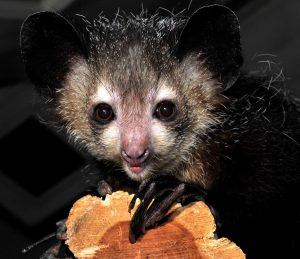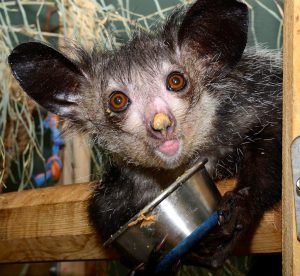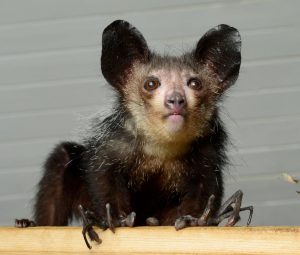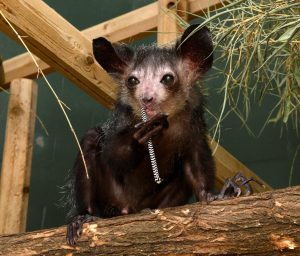FOR IMMEDIATE RELEASE: Wednesday, October 26, 2016
CONTACT: Karl Leif Bates | (919) 681-8054 | karl.bates@duke.edu
LEMUR CENTER REELING FROM SUDDEN DEATH OF FOUR AYE-AYES
DURHAM, N.C. — A mysterious affliction has killed four endangered aye-ayes at the Duke Lemur Center in the last 24 hours.
All four — two males and two females ranging in age from 7 to 28 years — wee stricken suddenly and died in the emergency care of two of the world’s foremost lemur veterinarians.
“We have experienced a tragedy,” said Lemur Center Director Anne Yoder “The staff is devastated.”
“This happened very quickly,” said operations director Greg Dye. A technician entering the enclosure where the stricken aye-ayes were housed noticed lethargic behavior at around 3 p.m. Tuesday and transported two animals to the Center’s emergency room within minutes. “The first one died within 20 minutes of being brought to our hospital,” Dye said.
Through the night, three more succumbed with similar speed.
Video cameras in the aye-ayes’ enclosures showed that “until about 2 o’clock yesterday afternoon, their behavior looked normal,” Dye said. A fifth aye-aye housed in the same area is under observation.
No other animals at the Center have been affected and the Center’s nine remaining aye-ayes appear to be unaffected, but the staff is closely monitoring all 250 lemurs every 30 minutes around the clock for signs of distress. Public tours of the Center never enter the areas where the stricken animals were housed and will continue as normal.
The aye-aye is so emblematic to the Duke Lemur Center that it is featured in the Center’s logo. They are cat-sized, gray-black creatures with enormous floppy ears, large round eyes and bushy black tails. They are active at night, hunting insects in tree trunks using teeth like a beaver and an extraordinarily thin and flexible middle figure that extracts their prey. They are also believed to be the most intelligent members of the lemur family, which are distant primate cousins to humans.
In all, there are fewer than 50 aye-ayes in captivity in the entire world, said Andrea Katz, the Lemur Center’s animal curator.
“We had 13 and now we have nine,” Katz said. “This is the most significant loss we’ve ever had and is a terrible blow to our breeding program. This is a significant percentage of the aye-ayes in the U.S. at this time.”
In their native Madagascar, aye-ayes are under severe threat due to habitat loss, hunting for meat, and an old superstition that they are evil and should be killed on sight.
Duke’s Lemur Center pioneered the breeding of aye-ayes in captivity, and many animals born in Durham are now housed around the country in zoos and conservation centers. Three of the four that died were born at Duke.
“What happened here is important for all of the aye-aye breeding colonies in the world,” Katz said. “I hope we can learn something that will prevent this from ever happening again.”
Dye said the investigation of possible causes of the deaths will look at the ambient air in the enclosure and the animals’ food and toys over the last 48 hours, and will include a very thorough post-mortem examination.
All four animals have been necropsied on site by the Lemur Center veterinarians who saw nothing obvious other than some fluid collection around the heart, said staff veterinarian Cathy Williams. Tissue and blood specimens have been collected and frozen and will be sent out for pathology and toxicology exams that could take a week or more.
Animal care authorities at Duke and beyond have been notified and consulted on the deaths.
Because the onset of illness and death were so swift, Lemur Center veterinarian Bobby Schopler said it was unlikely that an infectious agent would be to blame. But nothing’s being ruled out at this point. “There is probably a single cause,” he added.
“We are doing everything we can to figure this out,” Yoder said. “We have been entrusted with the care and conservation of these delicate and extraordinarily threatened animals.”
Yoder said lemurs in captivity at the Center typically live two or three times longer than they would in the wild because they are so well cared for.
“We won’t change our priorities or our commitment to these endangered species,” she said. “This kind of loss is one of the most awful consequences of this great responsibility we carry.”
——————-
These are the four aye-aye lemurs that died suddenly and mysteriously at the Duke Lemur Center on October 25 and 26. Most members of the aye-aye colony at Duke have names in a horror movie theme, because of their odd appearance and nocturnal habits.

Norman Bates, age 7.5, was the son of Hitchcock and Morticia. A vigorous aye-aye, he was renowned throughout the Center for his feistiness and intelligence. He had not yet been designated a breeding animal.

Angelique, age 11, made worldwide headlines in September 2005 by being the first aye-aye born to parents (Merlin and Ardrey) who themselves had been born in captivity. Although she was compatible with two different males, she was not a designated breeder and had produced no offspring. She was Morticia’s granddaughter.

Merlin, age 22, was the son of Nosferatu and Endora and was born at the DLC. He spent six years on loan to the San Francisco Zoo and then returned to the DLC to produce three infants, all of which survived to adulthood, including Angelique, another of the four who died Wednesday morning. Merlin was a star in the DLC’s non-invasive research programs because of his focus and cooperation. He provided a thrill to some lucky DLC visitors by carefully extracting mealworms from their fists with his slender middle finger.

Morticia was nearly 28 years old and the mother of seven aye-ayes bred in captivity at the Lemur Center, including Norman Bates, who preceded her in death by 12 hours in this same tragedy. She arrived in December 1991 as one of the original eight wild-caught aye-ayes brought to the Lemur Center from Madagascar to establish a breeding program. All of her offspring survived to adulthood, one of whom bore twins at the Bristol Zoo in the UK. She has one daughter, Ardrey, surviving at the Lemur Center, and sons in Philadelphia and Japan.

